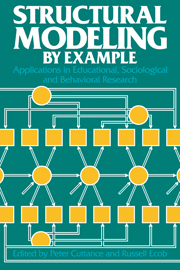Book contents
- Frontmatter
- Contents
- Preface
- List of contributors
- 1 Introduction
- 2 An overview of structural equation modeling
- 3 Field dependence and the differentiation of neurotic syndromes
- 4 High school seniors' reports of parental socioeconomic status: black–white differences
- 5 Modeling the hierarchical structure of learning
- 6 A study of longitudinal causal models comparing gain score analysis with structural equation approaches
- 7 Some structural equation models of sibling resemblance in educational attainment and occupational status
- 8 Applications of structural equation modeling to longitudinal educational data
- 9 The robustness of maximum likelihood estimation in structural equation models
- 10 An inquiry into the effects of outliers on estimates of a structural equation model of basic skills assessment
- 11 Testing structural equation models
- 12 LISREL models for inequality constraints in factor and regression analysis
- 13 Issues and problems in the application of structural equation models
- Appendix
- Glossary
- Index
7 - Some structural equation models of sibling resemblance in educational attainment and occupational status
Published online by Cambridge University Press: 12 January 2010
- Frontmatter
- Contents
- Preface
- List of contributors
- 1 Introduction
- 2 An overview of structural equation modeling
- 3 Field dependence and the differentiation of neurotic syndromes
- 4 High school seniors' reports of parental socioeconomic status: black–white differences
- 5 Modeling the hierarchical structure of learning
- 6 A study of longitudinal causal models comparing gain score analysis with structural equation approaches
- 7 Some structural equation models of sibling resemblance in educational attainment and occupational status
- 8 Applications of structural equation modeling to longitudinal educational data
- 9 The robustness of maximum likelihood estimation in structural equation models
- 10 An inquiry into the effects of outliers on estimates of a structural equation model of basic skills assessment
- 11 Testing structural equation models
- 12 LISREL models for inequality constraints in factor and regression analysis
- 13 Issues and problems in the application of structural equation models
- Appendix
- Glossary
- Index
Summary
Introduction
Sociologists and economists have long recognized the importance of measuring the effects of schooling. Its influence on such measures of success as occupational status and earnings serves, on the one hand, as an indicator of the role of educational institutions in fostering (or hampering) social mobility and, on the other hand, as an indicator of the productivity of personal and public investments in schooling. At the same time, it is well known that social and economic success may depend directly on personal characteristics and conditions of upbringing that also affect the length and quality of schooling. For these reasons, it is by no means obvious that an association of schooling with social or economic success can be interpreted in causal terms, and many studies have attempted to determine the degree to which such causal inferences are warranted.
The effects of background, broadly conceived, on achievement can be taken into account by modeling the similarity of siblings. That is, a research design based on sibling pairs (or w-tuples) permits a statistical decomposition of variances and of covariances into “between-family” and “within-family” components. If fraternal differences in schooling lead to differences in adult success, we can be confident that the association of schooling with success is not merely an artifact of the tendency of school success to run in families that are also economically successful. This has helped to motivate a number of studies of the stratification process that are based on samples of siblings, rather than of the general population, perhaps most notably in the two major studies by Jencks and associates (1972, 1979).
- Type
- Chapter
- Information
- Structural Modeling by ExampleApplications in Educational, Sociological, and Behavioral Research, pp. 108 - 137Publisher: Cambridge University PressPrint publication year: 1988
- 4
- Cited by

